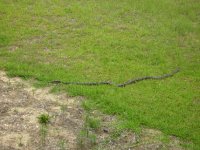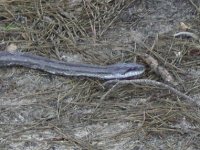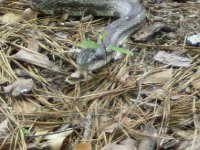-
Welcome to BirdForum, the internet's largest birding community with thousands of members from all over the world. The forums are dedicated to wild birds, birding, binoculars and equipment and all that goes with it.
Please register for an account to take part in the discussions in the forum, post your pictures in the gallery and more.
You are using an out of date browser. It may not display this or other websites correctly.
You should upgrade or use an alternative browser.
You should upgrade or use an alternative browser.
What kind of snake is this? (1 Viewer)
- Thread starter bamabluebird
- Start date
More options
Who Replied?stronzo
Well-known member
I am guessing it is a grey rat snake, but a location would be helpfulbamabluebird said:We're thinking that it may be a ratsnake, but not sure.
Mark
bamabluebird
Well-known member
i live in central alabama if that's what you mean. i live out in the country so there are lots of open fields around my house. i haven't seen him since so hopefully he was "just passin' thru" and won't bother any of my birds.
keith richter
Well-known member
it looks poisonous. becuse if you look at the head if it is like a diamond it is poisonous. and i think it is a rat snake
Isurus
Well-known member
I thought rat snakes were non-venemous?keith richter said:it looks poisonous. becuse if you look at the head if it is like a diamond it is poisonous. and i think it is a rat snake
bamabluebird
Well-known member
Me too
stronzo
Well-known member
bamabluebird said:i live in central alabama if that's what you mean. i live out in the country so there are lots of open fields around my house. i haven't seen him since so hopefully he was "just passin' thru" and won't bother any of my birds.
It is a grey rat snake then. It is not poisonous, but it may take the odd bird I am afraid. But don't let that put you off, snakes have a bad press and need our help as much as the birds do.
Mark
bamabluebird
Well-known member
well, at least i know for sure what it was. haven't seen it since. i didn't think it was poisonous. it obviously wasn't aggressive either. my boyfriend was taking the pictures of it (and getting kind of close to do that) and trying to steer it clear of the bird feeding area (it was headed straight for it!) and it didn't even try to strike.
mothman
Well-known member
Rat snakes are venomous but are "Back fanged"this means that the fangs are at the back of the mouth and not the front rendering this species unable to strike.Isurus said:I thought rat snakes were non-venemous?
Colin.
stronzo
Well-known member
mothman said:Rat snakes are venomous but are "Back fanged"this means that the fangs are at the back of the mouth and not the front rendering this species unable to strike.
Colin.
No they are not, the north American Ratsnakes are not rear fanged or venomous.
Mark
LAF
Registered Member
stronzo1 said:No they are not, the north American Ratsnakes are not rear fanged or venomous.
Mark
Exactly. While the majority of colubrids do posses venom glands (formerly viewed as unique organels - Duvernoys glands - but now taken at face value again) there are still some that don't. Additionally, many venomous colubrids do not posses the modified dentition be be classed as rear fanged. For example, in the US Hognosed snake and Lyre snakes are rear fanged and venomous. The coachwhips are venomous but not rear fanged, while the American ratsnakes, kings, milks, gopher/bull snakes are non-venomous. The ratsnake issue can cause confusion as many Asian species are, indeed, venomous. But these are taxonomically very distinct from the American snakes of the same name.
A good bit of background info into this can be found on this PDF:
http://biology.bangor.ac.uk/~bss166/Publications/Colubritoxin.pdf
In the US, the only dangerously venomous snakes are the vipers/rattlers and the coral snake. All of which are easy enough to ID most of the time (biggest risk for confusion being corals/milksnakes and cottonmouth/water snakes).
The diamond shaped head division between ven. and non-ven. is woefully vague and is best forgotton as it doesn't work.
The snake pictured is indeed a ratsnake, Pantherophis obsoleta (Formerly Elaphe obsoleta).
Regards, Lee.
Evanji Axu
Spiteful Cynic
It looks like the black rat snakes we get here. They're very handsome. They bite when cornered but they're not dangerous. I remember seeing one on the road while Dad and I were out biking. He looked kind of kinked up, which, upon research, the rat snakes do when startled.
For the pit vipers, the broad head is the best identification. For coral snakes..."red touch yellow/dangerous fellow/red touch black/safe for Jack"
For the pit vipers, the broad head is the best identification. For coral snakes..."red touch yellow/dangerous fellow/red touch black/safe for Jack"
SalidMonster
Well-known member
BRsnake
I think it looks like the species is Rat snake. Black, Gray, Baird's, Texas, Yellow and Everglades Rat Snakes are all subspecies of Rat Snake. I would say yours subspecies is the Black Rat Snake - a very common snake in the south east.
bamabluebird said:We're thinking that it may be a ratsnake, but not sure.
I think it looks like the species is Rat snake. Black, Gray, Baird's, Texas, Yellow and Everglades Rat Snakes are all subspecies of Rat Snake. I would say yours subspecies is the Black Rat Snake - a very common snake in the south east.
motacilla oenenthe
Well-known member
LAF said:Exactly. While the majority of colubrids do posses venom glands (formerly viewed as unique organels - Duvernoys glands - but now taken at face value again) there are still some that don't. Additionally, many venomous colubrids do not posses the modified dentition be be classed as rear fanged. For example, in the US Hognosed snake and Lyre snakes are rear fanged and venomous. The coachwhips are venomous but not rear fanged, while the American ratsnakes, kings, milks, gopher/bull snakes are non-venomous. The ratsnake issue can cause confusion as many Asian species are, indeed, venomous. But these are taxonomically very distinct from the American snakes of the same name.
A good bit of background info into this can be found on this PDF:
http://biology.bangor.ac.uk/~bss166/Publications/Colubritoxin.pdf
In the US, the only dangerously venomous snakes are the vipers/rattlers and the coral snake. All of which are easy enough to ID most of the time (biggest risk for confusion being corals/milksnakes and cottonmouth/water snakes).
The diamond shaped head division between ven. and non-ven. is woefully vague and is best forgotton as it doesn't work.
The snake pictured is indeed a ratsnake, Pantherophis obsoleta (Formerly Elaphe obsoleta).
Regards, Lee.
i seem to remember something about indian cobras escaping into the wild in florida some time ago.....
keith richter
Well-known member
im not a snake expert. 
Users who are viewing this thread
Total: 2 (members: 0, guests: 2)






